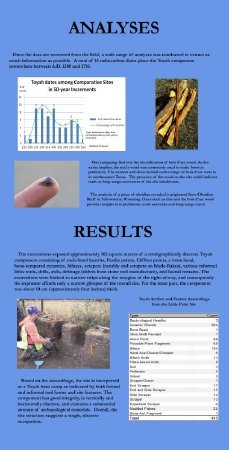Title:
Panel 4: Analyses & Results
Collection:
Little Paint Collection
Object ID:
CAS.2013.07.PIC.85
VE Exhibit Label 1:
ANALYSES
Once the data are recovered from the field, a wide range of analyses was conducted to extract as much information as possible. A total of 15 radiocarbon dates place the Toyah component somewhere between A.D. 1380 and 1710.
Once the data are recovered from the field, a wide range of analyses was conducted to extract as much information as possible. A total of 15 radiocarbon dates place the Toyah component somewhere between A.D. 1380 and 1710.
VE Exhibit Label 2:
One intriguing find was the identification of bois d'arc wood. As the name implies, the tree's wood was commonly used to make bows in prehistory. The nearest well—documented native range of bois d'arc trees is in northeastern texas. The presence of the wood on the site could indicate trade or long range movement of the site inhabitants.
The analyses of a piece of obsidian revealed it originated from Obsidian Bluff in Yellowstone, Wyoming. Clues such as this and the bois d'arc wood provide insights into prehistoric trade networks and long—range travel.
The analyses of a piece of obsidian revealed it originated from Obsidian Bluff in Yellowstone, Wyoming. Clues such as this and the bois d'arc wood provide insights into prehistoric trade networks and long—range travel.
VE Exhibit Label 3:
RESULTS
The excavations exposed approximately 102 square meters of a stratigraphically discrete Toyah component consisting of rock—lined hearths, Perdiz points, Cliffton points, a bone bead, bone—tempered ceramics, bifaces, scrapers (notably end scrapers on blade flakes), various informal litich tools, drills awls, debitage (debris from stone tool manufacturing), and faunal remains. The excavations were limited to narrow strips along the margins of the right—of—way, and consequently the exposure affords only a narrow glimpse of the overall site. For the most part, the component was about 10cm (approximately four inches) thick.
Based on the assemblage, the site is interpreted as a Toyah base camp as indicated by both formal and informal tool forms and site features. The component has good integrity, is vertically and horizontally discrete, and contains a substantial amount of archaeological materials. Overall, the site structure suggests a single discrete occupation.
The excavations exposed approximately 102 square meters of a stratigraphically discrete Toyah component consisting of rock—lined hearths, Perdiz points, Cliffton points, a bone bead, bone—tempered ceramics, bifaces, scrapers (notably end scrapers on blade flakes), various informal litich tools, drills awls, debitage (debris from stone tool manufacturing), and faunal remains. The excavations were limited to narrow strips along the margins of the right—of—way, and consequently the exposure affords only a narrow glimpse of the overall site. For the most part, the component was about 10cm (approximately four inches) thick.
Based on the assemblage, the site is interpreted as a Toyah base camp as indicated by both formal and informal tool forms and site features. The component has good integrity, is vertically and horizontally discrete, and contains a substantial amount of archaeological materials. Overall, the site structure suggests a single discrete occupation.
